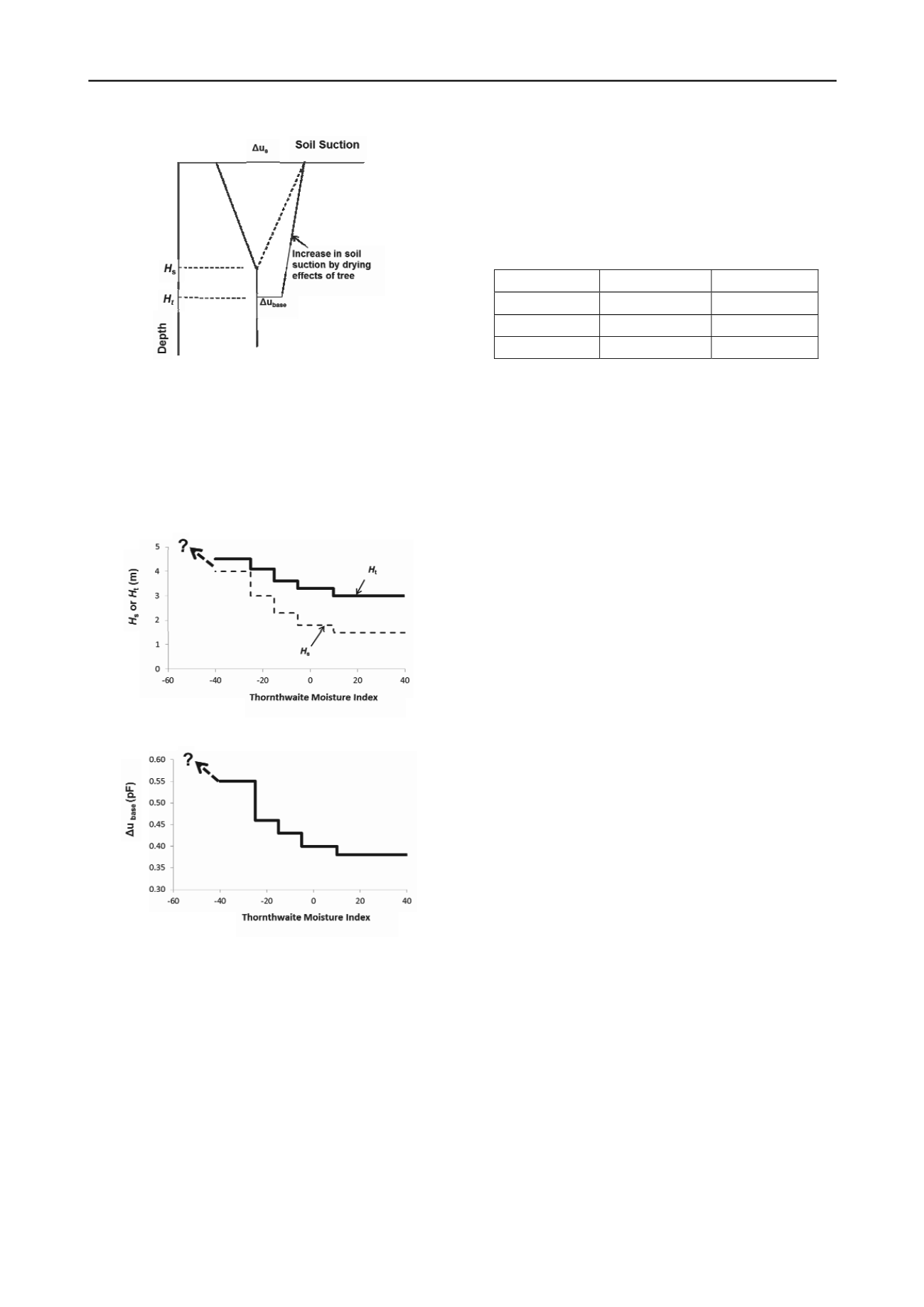
1161
Technical Committee 106 /
Comité technique 106
Figure 2. Design soil suction extremes for a site with a group of trees by
AS2870-2011
By AS2870-2011, the parameters
H
s
,
H
t
, and Δu
base
increase
with a decreasing Thornthwaite Moisture Index for the site as
shown in Figure 3 for
H
s
, and
H
t
(
H
t
is shown for a tree group)
and in Figure 4 for Δu
base
(shown for a tree group). As the
magnitude and depth of soil suction changes increase with
decreasing TMI associated with a drying climate, by Equations
(4) and (5), expansive soil movements will increase.
Figure 3. Relationships between
H
s
and
H
t
and TMI by AS2870-2011
Figure 4. Relationship between Δu
base
and TMI by AS2870-2011
For the predicted future decrease in TMI of a location shown
in Table 2, the increased depths of soil suction changes
H
s
and
H
t
and the increased soil suction change Δu
base
can be determined
from Figures 3 and 4 respectively, and the predicted increase in
soil movement can then be calculated from the soil suction
changes by Equations (4) and (5).
6 EXAMPLE
The author (Mitchell 2011, 2012) has illustrated the implications
of a predicted decrease in TMI by determining the soil
movement at present, in 2030 and in 2070, for a site in
Melbourne for a group of trees where
y
tmax
from Equation (5) is
equal to
y
t
, for a soil profile assumed for simplicity to be uniform
clay of
I
pt
=
2.5%
.
By Table 2, the TMI at present, and as predicted in 2030
and 2070, are respectively -8, -14, and -24. By Figure 3, the
values of
H
s
corresponding to these TMI values are respectively
2.3 m, 3.0 m and 4.0 m, and the
H
t
values are respectively 3.6 m,
4.1 m and 4.5 m, and by Figure 4, Δu
base
= 0.43, 0.46 and 0.55
respectively.
Table 3 summarises the results of the predicted soil
movement by Equations (4) and (5) for the Melbourne site.
Table 3: Predicted Soil Movement for a site in Melbourne
y
s
(no trees)
y
s
+
y
t
(with trees)
Present
35 mm
65 mm
2030
45 mm
75 mm
2070
60 mm
95 mm
It can be seen from Table 1 that a significant increase in
predicted soil movement is expected with climate change.
Therefore a continuing revision of footing design standards
would be required in order to cater for the effects of climate
change.
7 CONCLUSIONS
This paper has shown how climate change effects on expansive
soil movements can be quantified using the Thornthwaite
Moisture Index (TMI). This is because the TMI is calculated
from the moisture deficiency and surplus, both related to rainfall,
and the potential evapotranspiration which is derived from
temperature, so that predicted temperature increases and rainfall
reductions in 2030 and 2070 can used to derive the future TMI
of an area. Values of TMI at present, in 2030 and 2070 were
derived for Adelaide, Melbourne, Perth and Sydney. Established
relationships between TMI and the depth and magnitude of soil
suction changes for sites with and without the presence of trees,
and the relationships between soil movement and soil suction
changes, are used to predict the increase in soil movement for a
site. A specific example is given for Melbourne for a site without
trees and with a group of trees. It is shown that a significant
increase in predicted soil movement is expected with climate
change. This implies that a continuing revision of expansive soil
movement predictions and footing design standards would be
required in order to cater for the effects of climate change.
8 REFERENCES
Stern, N. 2007. “The Economics of Climate Change – The Stern
Review”. Cambridge University Press, 712 p., January.
CSIRO (Commonwealth Scientific & Industrial Research Organisation),
2007. “Climate Change in Australia”, Technical Report.
Thornthwaite, C.W. 1948. “An Approach toward a Rational
Classification of Climate”, Geographical Review, Vol. 38, 55-94.
AS 2870 – 2011. “Residential Slabs and Footings – Construction”,
Standards Australia, Homebush, NSW, Australia.
Mitchell, P.W. 2011. “Climate Change and Challenges for Geotechnical
Engineers”. Proceedings International Conference on Advances in
Geotechnical Engineering, 21-29. Perth, Nov.
Mitchell, P.W. 2012. “Footing Design for Tree Effects Considering
Climate Change”. Proceedings 2012 ANZ Geomechanics
Conference, Melbourne. Paper No. 1.3.11, 290-295, July.


